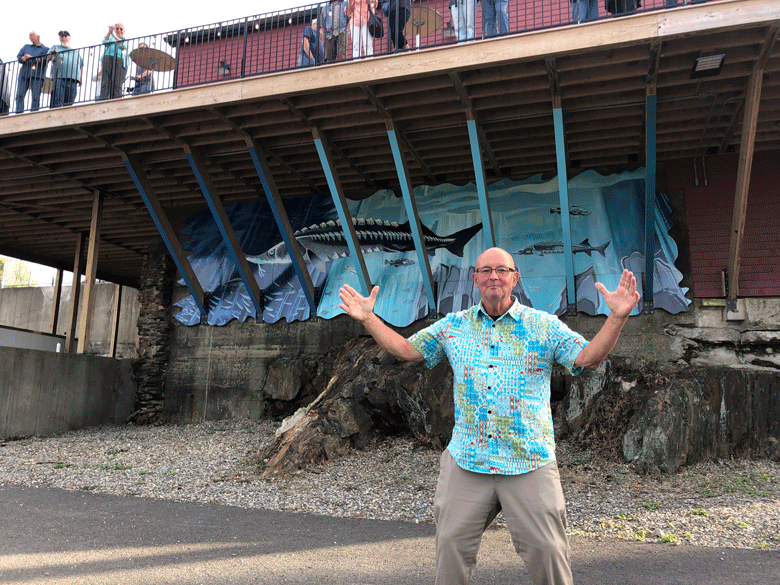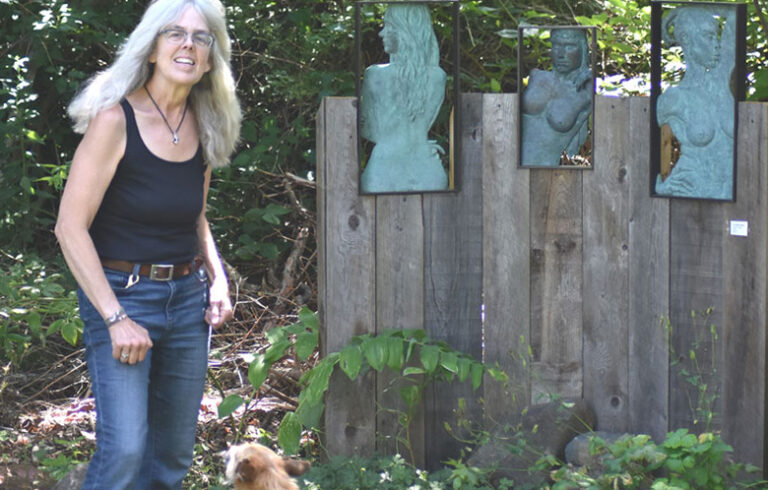Let’s get the pronunciation lesson out of the way first. The river that flows into Penobscot Bay in Belfast is called the Passagassawakeag, which in the native Wabanaki language means, “Place where sturgeon may be speared by torch light.”
It’s pronounced: puh-SAG-uh-sa-WAW-keg.
There don’t seem to be many sturgeon in the river today, but that hard-to-pronounce name and its meaning are part of Belfast’s identity. And so it made sense for local artist David Hurley to propose painting a mural on a prominent building along the city’s harbor walk.
The building had been a garage for a Belfast fuel company’s fleet, but in recent years it was purchased by Paul Naron, who came to town about ten years ago and has turned a former window and door company’s warehouse into a year-round farmers market.
“It was like creating a puzzle,” he said of the 34-foot long mural.
Naron has renovated the garage building into the Bayview Point Events Center, and Hurley, who had completed a mural for the farmers market building, pitched the idea of painting a sturgeon on the lower portion of the event center. Hurley said Naron was less than enthusiastic about paying for it, and suggested he raise the money elsewhere.
Hurley easily raised the funds, he said, and then came the planning.

“I knew I wanted a really big sturgeon,” he said, and he wanted the scene to reflect an ecosystem. “I included cod, other sturgeon, pogies.”
Since the building includes trusses that support a large deck overlooking the water, Hurley decided to paint the scene on 18, 4-foot-high plywood panels. The process included creating a scale model of each panel. Then he found that the trusses didn’t conform to regular measurements, and so they had to be cut and shaped.
“It was like creating a puzzle,” he said of the 34-foot long mural. Trying to assemble the pieces in his garage didn’t work, so a friend who got to know Hurley when he painted a mural at the city’s airport offered the use of a hangar.
Painting began on May 17, which would have been his father’s 100th birthday and concluded in July.
“It’s funny,” Hurley mused. “You have this idea, but then it’s like, how do I do this? I had a hundred problems to solve.”
At the public opening for the mural, Hurley brought in musicians—including Native drummers and an academic to speak about sturgeon.
Naron installed a panel listing facts about sturgeon along the city’s public harbor walk, and more information will be added near the building, Hurley said.
Though sturgeon are not seen—or at least, seen with any regularity—in the river, Hurley remains confident they are there.
“No one sent the sturgeon a letter saying ‘Don’t come here,’” he said.
Belfast’s poet laureate this year is Maya Stein, and she wrote and read this poem at the mural’s dedication:
knowing sturgeon
BY MAYA STEIN
What I know about sturgeon
could fit in the gap between two
of my knucklebones. But because
this is a poem about sturgeon,
I’m wondering about sturgeon bones,
and how many they have
And it turns out they don’t have any,
that their skeleton is made of cartilage
and an armor of plates down their sides,
and I try to imagine what it would be like
to have a body with only cartilage for bones,
and armor down my sides.
What I know about sturgeon
could fit in the shallow glass
by the side of the sink
where I brush my teeth,
but because this is a poem about sturgeon
I’m wondering how many teeth sturgeon have,
and it turns out they don’t have any teeth,
and instead drag whiskers called “barbels” on the bottom
of the sea to catch what they eat, and I try to imagine
what it would be like to have to drag my chin
on the bottom of the sea
for my dinner.
What I know about sturgeon could fit inside
the pencil case I took to school in 4th grade,
when for the first time,
I learned to write a poem.
But because this is a poem about sturgeon,
I am wondering if sturgeon move in the way of other fish,
(you know, in schools)
and it turns out they spend more time alone,
traveling in the open sea for years before returning
to the coast to spawn, and I try to imagine
what it would be like to manage
the turbulent waters of the world
with so little company.
What I know about sturgeon
could fit in the back pocket of my jeans
where I keep loose notes and receipts
and sometimes a $5 bill just in case,
but because this is a poem about sturgeon,
I am wondering about all the empty spaces
I could fill with notes about sturgeon,
facts and figures and scientific names,
what would make me sound as if I knew something
beyond the gaps between knucklebones and a shallow glass
and my pencil case and my pockets.
There are so many books to read
and I know so little about sturgeon.
But to know a thing is not these things.
To know a thing, you have to lean into
the whispers of its briny cells.
You have to sniff the fossils of its memory.
To know a thing you have to listen to its language,
even when it’s unfamiliar or absent of words,
and especially then.
To know a thing, you have to honor
the stories of those who knelt at the river first,
who prayed to the movements in the water
and held sacred the current.
To know a thing you have to travel deeper
than your eyes can see, and your mouth can speak.
You have to bow to the mysteries of what is underneath,
so far below
and beyond.
To know a thing, you have to put the books down.
You have to open your arms wider than your own imagination. You have to let go of the edge of understanding.
To know a thing, you have to swim
toward where the sturgeon go,
even if you never get there,
and perhaps, especially then.





